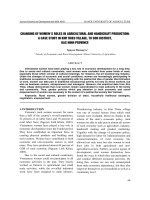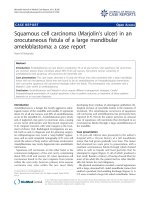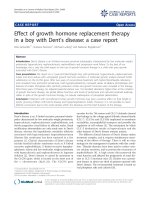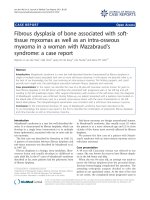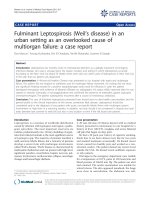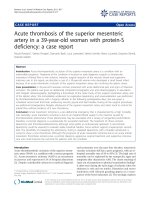VIOLATION OF GRICE’S MAXIMS IN CASE OF JOKES
Bạn đang xem bản rút gọn của tài liệu. Xem và tải ngay bản đầy đủ của tài liệu tại đây (149.03 KB, 15 trang )
0
VIETNAM NATIONAL UNIVERSITY
UNIVERSITY OF LANGUAGES AND INTERNATIONAL STUDIES
DEPARTMENT OF POST-GRADUATE STUDIES
VIOLATION OF GRICE’S MAXIMS
IN CASE OF JOKES
SEMANTICS COURSE
(Final assignment)
Student:
Nguyen Thi Hong Vinh
Group:
K18C
Supervisor:
Ha Cam Tam, Dr.
Date of submission: 30/06/2010
Hanoi, 2010
Nguyễn Thị Hồng Vinh
Final assignment
1
TABLE OF CONTENT
PART A: INTRODUCTION
1. Rationale of the study
2. Aims of the study
3. Scope of the study
4. Method of the study
PART B: DEVELOPMENT
1. Theoretical background
1.1.
Grice’s maxims of conversation
1.2.
Jokes and Joke types
2. Violation of Grice’s Maxims in jokes
2.1.
Violation of Grice’s Maxims
2.2.
Violation of Grice’s Maxims in Jokes
2.2.1. Violation of the Maxim of Quantity
2.2.2. Violation of Maxim of Quality
2.2.3. Violation of Maxim of Relation
2.2.4. Violation of Maxim of Manner
PART C: CONCLUSION
REFERENCES
Nguyễn Thị Hồng Vinh
Final assignment
2
PART A: INTRODUCTION
1. RATIONALE OF THE STUDY
The philosopher Paul Grice proposed four conversational maxims which are
a way to explain the link between utterances and what is understood from them. The
Maxims are based on his cooperative principle which states “‘Make your
conversational contribution such as is required, at the stage at which it occurs, by the
accepted purpose or direction of the talk exchange in which you are engaged,’.
Following cooperative principle, listeners and speakers must speak cooperatively
and mutually accept one another to be understood in a particular way. In other
words, speakers try to contribute meaningful, productive utterances to further the
conversation. Based on these principles, people can know how effective
communication in conversation is achieved in common social situations. However,
there are many cases in which someone might be uncooperative in conversation.
This phenomenon can be named as violation or flout Grice’s maxims. Perhaps some
people violate or flout Grice’s maxims in their conversation because they are being
interrogated for information which they do not want to give or because they hate the
person they are talking to, in other situations, they may be want to imply something
or sometimes some people just intend to make jokes. It seems that the case of jokes
is a remarkable example for the violation or flouting of Grice’s maxims. Many jokes
only make sense when hearer or readers realize that the basic rule in common
conversation or communication is somehow not normally followed. Finding out the
principles which are violated means understanding the jokes. Many English jokes I
have read before confused me because I could not discover why English people find
it funny; therefore I am really interested in investigating the way joke stories flout or
violate the Grice’s Maxim. By doing this, I hope that I have more chances to
understand more profoundly joke stories. That is the reason I choose the topic “An
investigation into the ways different types of joke violate Grice’s maxims”
Nguyễn Thị Hồng Vinh
Final assignment
3
2. AIMS OF THE STUDY
The study is expected to reach the following purposes:
-
Have an overview of the violation of Grice’s Maxims
-
Explore the ways in which different types of joke violate Grice’s Maxims
3. SCOPE OF THE STUDY
The research aims at providing an investigation into the ways different types
of joke flouting Grice’s maxims. In order to make the task manageable in keeping
the aims of the research, within the paper length allowance, it is intended that not
every types of jokes will be listed here to analyze whether it violate the Grice’s
maxims or not. The focus of this study is only analyzing the way several jokes
violating Grice’s maxims without listing them in any particular joke types.
4. METHODS OF THE STUDY
Some methods applied to carry out this research are:
-
Collecting many joke stories
-
Reading about Joke, about Grice’s maxims
-
Analyzing the way some chosen joke stories flouting the four principles of
Grice’s maxims
Nguyễn Thị Hồng Vinh
Final assignment
4
PART B: DEVELOPMENT
1. THEORETICAL BACKGROUND
1.1.
Grice’s maxims of conversation
Grice is the first person who advanced the theory of the cooperative principle
in Harvard University, 1967. Grice says, all of actions communication, in order of
achieve the specific destination, there is a tacit agreement between the speaker and
hearer, an agreement that both sides are expected to observe. It tries to explain how a
speaker can mean more than what he says and how a hearer perceives what the
speaker really means. Grice thinks there is a set of assumptions governing the
conduct of conversation. This is what he calls the cooperative principle. He
formulates the principle and its maxims in “Logic and Conversation” (1975) named
Maxims of Quality, Quantity, Relevance and Manner.
Maxim of Quality: Be Truthful
Do not say what you believe to be false.
Do not say that for which you lack adequate evidence.
Maxim of Quantity
Make your contribution as informative as is required
Do not make your contribution more informative than is required.
Maxim of Relation:
Be relevant. This is the most important maxim, since it is responsible for preventing
random, incoherent conversations lacking any continuity.
Maxim of Manner: Be Clear
Avoid obscurity of expression.
Avoid ambiguity.
Be brief (avoid unnecessary prolixity).
Be orderly.
Nguyễn Thị Hồng Vinh
Final assignment
5
1.2.
Jokes and Joke types
According to Encyclopedia, a joke is a short story or short series of words
spoken or communicated with the intent of being laughed at or found humorous by
the listener or reader. Most jokes contain two components: joke setup (for example,
"A man walks into a bar...") and a punch line, which, when juxtaposed with the
setup, provides the necessary irony to elicit laughter from the audience. Jokes can be
categorized into many differing topics relating to their content and punch line, and
also there are many ways to classify joke and sometimes many jokes fit into more
than one category. Here listed some main popular types of joke: Yo' mama jokes,
Question–answer, Dirty jokes, Sick jokes,
Blonde jokes, Jokes about animals,
Shaggy dog stories, Duck jokes, Religion in jokes, Knock-knock jokes (Puns),
Profession-targeted jokes, Light bulb jokes, Dead body jokes, Ethnic jokes,
Mathematics jokes
2. VIOLATION OF GRICE’S MAXIMS IN JOKES
2.1. Violation of Grice’s Maxims
Without cooperation, human interaction would be far more difficult and
counterproductive. For example, it would not make sense to reply to a question
about the weather with an answer about groceries because it would violate the
Maxim of Relation. Likewise, responding to a request for some milk with an entire
gallon instead of a glass would violate the Maxim of Quantity. However, it is
possible to violate a maxim intentionally or unconsciously and thereby convey a
different meaning than what is literally spoken. Many times in conversation, this
violation is manipulated by a speaker to produce sarcasm or irony. Speakers who
deliberately violate the maxims usually intend for their listener to understand their
underlying implication. (This violation can be called flouting). Conversationalists
can assume that when speakers intentionally flout a maxim, they still do so with the
aim of expressing some thought. Thus, the Grice’s Maxims serve a purpose both
when they are followed and when they are flouted.
Nguyễn Thị Hồng Vinh
Final assignment
6
With the Maxim of quantity, violation happens when speakers don’t say
enough or say too much. With the Maxim of quality, violation happens when
speakers deliberately lie or speakers communicate in a way that does not reflect an
honest intention. With the Maxim of relation, violation happens when speakers make
an irrelevant comment. With the Maxim of manner, violation happens when speakers
are obscure, ambiguous or disorganized.
2.2. Violation of Grice’s Maxims in Jokes
It is a common knowledge that joking, which typically results in laughter, is
essentially an intentional act that evolves from both the joker and the joke itself, and
is expected to be of interest to the listener, who usually turns into a key player once
the joke has been cracked. More often than not, the joker flouts one or more of the
maxims of conversation, in order to create more interest and suspense in his/her
joke. The examples below are going to analyze the humor in jokes caused by
violating cooperative principles of conversation in detail.
2.2.1. Violation of the Maxim of Quantity
Observing the maxim of quantity, the interlocutors should not make their
contributions more or less informative than is required. The following jokes are
formed through the violation of the maxim of quantity.
Joke 1:
Mallon sat in his attorney's office.
-
Do you want the bad news first or the terrible news? The lawyer asked.
-
Give me the bad news first.
-
Your wife found a picture worth a half-million dollars.
-
That's the bad news? Asked Mallon incredulously- I can`t wait to hear
the terrible news
-
The terrible news is that it’s of you and your secretary
In the conversation, the lawyer only told Mallon that his wife has found a
photo worth $5000. When Mallon heard the news, he was unbelievable that was a
Nguyễn Thị Hồng Vinh
Final assignment
7
bad news and has enough reason to trust that the “terrible news” also was good
news. Not until the lawyer told him what the terrible news in was. Obviously, it was
the lawyer didn`t offer as much as information that Mallon misunderstood. However
with this violation, the conversation becomes humorous.
Joke 2:
Aunt: How did Jimmy do his history examination?
Mother: Oh, not at all well, but there, it was not his faults. They asked him things
that happened before the poor boy was born.
In the conversation, if the mother answers the question “oh, not at all well”,
she is observing the maxim of quantity. But Jimmy`s mother provides too much
information. She ascribes Jimmy`s fail of history exam to the teacher who asks the
question before Jimmy`s was born. It sounds ridiculous. In fact, the mother tries to
shrink responsibility and give a good explanation for her son.
Joke 3:
Man: Excuse me; do you know what time it is?
Woman: Yes
The woman violates the maxim of quantity by not providing enough
information. In this conversation, the communicative purpose would succeed if the
asker got the information he expects - that is the exact time. Therefore in this
situation what the woman usually need to do is simply giving the exact time at that
asking moment or saying that she does not know what time it is. However in this
story, the answerer leaves the gap information unanswered. That she only says “yes”
to answer the yes-no question of the asker “Do you know what time it is?” creates
humor.
2.2.2. Violation of the Maxim of Quality
According to the maxim of quality, the interlocutors should not say what they
believe to be false. Neither should they say that for which they lack adequate
Nguyễn Thị Hồng Vinh
Final assignment
8
evidence. The following examples reflect the use of the technique of violating the
maxim of quality for humorous purposes:
Joke 4:
Bob: I had a rough time this morning. The farmer caught me in one of his peach
trees.
Barbara: Gosh! What did you do?
Bob: I told him one of his peaches fell down and I was trying to put it back!
At the end of the conversation Bob says, “I told him one of his peaches fell
down and I was trying to put it back!” What he told the farmer could not be
scientifically true; therefore, his response violates the maxim of quality, thus making
the conversation a joke.
Joke 5:
Butler: Professor, there's a bill collector at the door. I told him you were out, but he
wouldn't believe me
Absent-minded professor: No? Then I suppose 1'll have to go out sad tell him
myself.
In this joke, the butler says something he believes to be false. The absentminded professor is at home, yet the butler says he is not. Since the bill collector
doesn't believe what the butler said, the absent-minded professor responds to the
butler unexpectedly that he himself will go out to tell the bill collector that he is not
at home, which is funnily false and violates the maxim of quality one more time in
this situation, thus achieving the effect of humor.
2.2.3 Violation of the Maxim of Relation
According to the maxim of relation, the interlocutors should make their contribution
relevant. This maxim demands that the hearer should give answers relevant to what
the speaker has said in their dialogue. The technique of violating the maxim of
relation is obviously used in the following jokes:
Joke 6:
Nguyễn Thị Hồng Vinh
Final assignment
9
Jay, my brother - in - law, was studying political science at U. C.L.A. one summer.
Many mornings the lure of the beach won out over his obligation to attend class,
until finally he realized he’d fail the course if he missed any more lectures. When
Jay walked into class late, the professor interrupted his talk about folkways,
customs and mores. He consulted his seating chart, then called on Jay: “Please tell
the class what mores are.”
Jay’s sense of humor took over as he sang out, “When the moon hits your eye like a
pizza pie, that’s a mores are”
Jay is late for school; as a result, the professor asks him to explain what
mores is. It implies that it is not a good mores always late for class. Jay violates the
maxim of relation purposely and not answers correctly. But his reply teases the
professor and has a sense of humor.
Joke 7:
Below is a Jordanian political joke that was heard at the time of an Arab summit
conference in Amman (1986), which was officially called mu’tamar al-wifāq
wal-’itifāq (Conference of Reconciliation and Agreement) by the host country
(Jordan). This political joke violate both manner and relevance maxims
Ronald Reagan (the then American president) was holding a press conference in
Washington to discuss domestic issues. Out of the blue, a journalist stood up and
posed this question: "Mr. President, what do you think of al wi fak and al ’iti fak
Summit Conference in Amman?" The president had no idea what that was.
Improvising, however, he responded: "I think we fuck, but we don’t declare it".
As can be seen, the joke teller wanted to conversationally implicate that
President Regan knew nothing about what was happening in the rest of the world,
because he lacked a good education. To achieve this end, the joker made the
journalist flout the maxim of manner by struggling with the alliterative
pronunciation of the Arabic conference name, thus triggering a sexual scenario that
was taken at face value by the president although it was far-fetched, and then the
Nguyễn Thị Hồng Vinh
Final assignment
10
joker had the president flout the maxim of relation, in order to sustain his facevalue interpretation of the journalist’s question: "I think we fuck, but we don’t
declare it". These two violations succeed in creating laughter.
2.2.4. Violation of the Maxim of Manner
With the maxim of manner the interlocutors should not use words they know their
listeners will not understand or say things which they know could be taken multiple
ways. They should also not state something in a long, drawn-out way if they could
say it in a much simpler manner.
To achieve the effect of humor, the usually use technique of violating the maxim of
manner is the technique of violating the maxim of avoiding ambiguity. The
following jokes violate the maxim of manner in pronunciation, vocabulary and
syntax.
Ambiguity in pronunciation
Joke 8:
Betty was taken to the museum by auntie. They went into the Egyptian room, and
there saw a mummy.
Betty asked what it was.
“That is someone’s mummy, dear,” answered auntie.
“Auntie,” she confided, “I am glad my mammy’s not like that”
In this joke, the humor is produced by the same pronunciation of the two words
“mummy” and “mammy”. Betty misunderstands “mummy” - the dead body
preserved from decay in ancient Egypt as the word “mammy”- the mother. As a
result, she feels lucky that her mother doesn`t like that.
Ambiguity in vocabulary
Joke 9:
“Where is Washington?”
“He is dead.”
“I mean the capital of the United States?”
Nguyễn Thị Hồng Vinh
Final assignment
11
“They loaned it all to Europe.”
“Now do you promise to support the constitution?”
“Me? How can I? I have got a wife and six children to support”
The dialogue happens in an oral test when the electors have to register their name to
join the election. There are many ambiguous words in the short conversation, such
as Washington, capital and support. These words have various meanings. For
example, Washington is both the most important city of the USA and the name of its
first president in American history. Capital has one meaning”the most important city
in a country or area”, another meaning “a sum of money, especially one used to
produce more money or to start a business”. Support, in the same way, the first
means “to show approval of the constitution”, but the voter deliberately apprehend
as “to provide money or food for a person or a family to live on” .The vivid answer
from the voter achieves good sense of humor.
Ambiguity in syntax
Joke 10:
Two men wandering in a quiet cemetery found this tombstone:
THIS STONE WAS ERECTED
IN MEMORY OF
JAMES MACMILAN
WHO WAS DROWNED
IN THE RIVER SEVEN
BY SOME OF HIS
CLOSEST FRIENDS
We have two ways to understand the words engraved in this tombstone. If the
“By” structure is subordinated to past-participle “erected”, it means his friends make
the tomb for him. But if the “By--” structure is attaching to the word “drowned”, it
means that it was his closest friends who pushed James Macmilan in the Rice seven.
Maybe the answer is just he himself can know it.
Nguyễn Thị Hồng Vinh
Final assignment
12
There are other ways to achieve the humor for specific destination as the
example below:
Joke 11:
Policeman (producing note book): “Name please”.
Motorist: “Aloysius-Alastaer-Cyprian-“
Policeman (putting book away): “well, don’t let me catch you again.”
The conversation flouts one of the requirements of the maxim of manner-Be
brief. The policeman catches a driver who breaks the traffic rules and would have to
write down his name. But the driver is crafty and he tells the policeman a long,
eccentric and uneasy to read and write name, hence the policeman has to give up
inquiring his responsibility. The driver deliberately violates the maxim of manner to
avoid the punishment.
There are even some jokes that violate all four Grice’s maxims. Take the joke
below as an example:
Joke 12:
Steven: Alfred is meeting a woman for dinner tonight
Susan: Does his wife know about it?
Steven: Of course, she does. The woman he’s meeting is his wife!
This kind of humor flouts all four maxims. It flouts the Maxim of Quantity when
Steven uses the word “Woman” for “wife”; it means that he is withholding the
information, not being as informative as he should be. It is also flouting the Maxim
of Quality since Steven knows that woman is Alfred’s wife. He also flouts the
Maxim of Relation. It is a common knowledge that a woman when connecting to an
adult married male implies adultery or sexuality and never means as “wife”. The last
is flouting the Maxim of Manner, since Steven does not speak clearly at the
beginning that the woman is the wife or he deliberately speaks ambiguously to
create laughter.
Nguyễn Thị Hồng Vinh
Final assignment
13
In the study above, we have many examples to demonstrate the universality in jokes.
We also know, in the conversation it is not always the hearer’s violation the
“cooperative principle”, so that the speaker will be taken in. Sometimes it was the
speaker who first violates the cooperative principle, accordingly there is a relative
relationship to observed or violate the cooperative principle. In our life, the hearer
make use of the opportunity when the speaker unintended violates the Grice’s
Maxims, and then to get the sense of humor.
PART C: CONCLUSION
Humor is a seasoning of life. No matter what embarrassment or other troublesome
situation, humor smoothes us to get out of the awkward position and to help the
problem solved. In this study, I have tried to analyze the humor caused in joke
stories by violating the four Grice’s maxims. As shown in the examples above, it
will achieve effects of conversation implicit beyond we expect because of violation
one or some maxims of cooperative principle, especially in humorous conversation.
Of course, the results which lead to humor are not just only violation of cooperative
principle. Others such as violation of the maxims of courtesy, suing the language
relativity, misusing of the language, etc. all that can reach the effects of humor.
However, to grasp the reason of humor production by analyzing some joke violating
Grice’s Maxims, it will benefit us, the non-English country people to thoroughly
understand English culture, and more proficiently to use this language
REFERENCES
Nguyễn Thị Hồng Vinh
Final assignment
14
1. S. Attardo. Violations of conversational maxims and cooperation: The case of jokes.
Journal of Pragmatics 19 (1), 1993, 537-558
2. Grice, H. Paul. (1975). Logic and Conversation. In Cole, P. and J. Morgan (eds.),
41-58
3. Raskin, V. (1985). Semantic Mechanisms of Humor. Dordrecht: Reidel.
4. />5. />6. />7. />8. />9. />10. www.msvu.ca/site/media/msvu/BJDP229.pdf
11. www.cog.brown.edu/courses/cg45/.../Gricean%20Maxims.pdf
12. www.laurahughes.com/art/grice.doc
13. />14. cscanada.net/index.php/css/article/view/449/pdf_288
Nguyễn Thị Hồng Vinh
Final assignment

